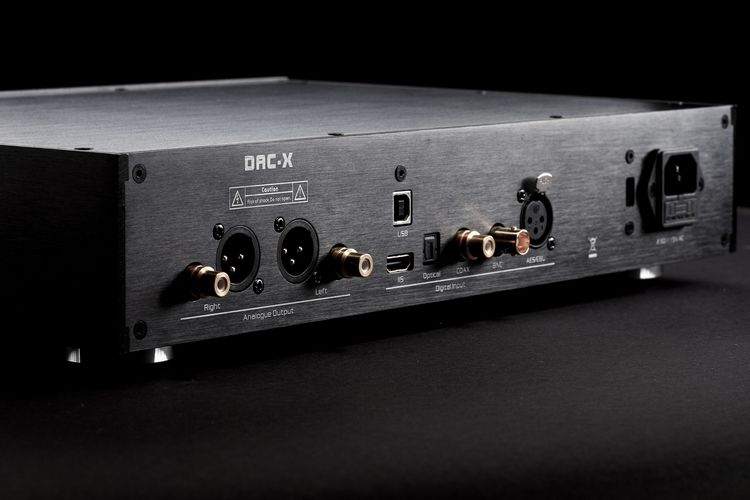Ta recenzja jest archiwalna i pochodzi z 2016 roku.
Nie jestem fanem przetworników delta sigma, ze względu na ich sztuczne brzmienie, ale są lepsi i gorsi wśród tej kategorii, a ten dac w rodzinie Gustarda jest dość ciekawy.
GUSTARD DAC-X20U (poprawiona wersja X20), z pilotem i regulacją głośności.
Wewnątrz też się nieco różni od starszej wersji X20.
2 x ESS Technology ES9018 Sabre Reference 32bit
XMOS 32bit/500MIPS
Adopt more humane modular XMOS USB daughter card.
Analog circuit use High-end discrete lines.
Features:
1. Dual ESS Technology Sabre Reference 32bit ES9018 DAC chip,R and L sound Chanel one on each side。
2.Automatic adaptation master clock technology and Asynchronous master clock technology。
Two clock mode can be freely selected.
3. XMOS 32bit USB receiver chip which is best performance asynchronous USB audio solution.
4.CPLD programmable logic device. Soft control ES9018.
5. Three files gain, volume can be adjusted. Attenuation adjustable from 0 to -99DB.
6. TFT LCD screen, adjustable contrast.
7. Power supply with two O-type transformers, Digital and Analog independent power supply, and use Discrete Components regulation Voltage stabilization.
8. Full balance Discrete components Analog Line. Balance / RCA output simultaneously.
9. Digital Input: balanced Spdif AES/EBU port, RCA, Toslink Optical input and USB, (Key switch)
10. Both 110/120v and 220/240v version supported.
11.Power Supply: AC 230V 50 / 60Hz (AC 115V 50 / 60Hz),Power Consumption: <50W
12.Dimensions (excluding protruding part): W 380MM * H 65MM * D 260MM
Specification:
DAC:
ESS Technology ES9018 Sabre Reference 32-bit DAC
8 mono to 2 stereo configuration,four D/A converters per channel
Digital Input:
Coaxial, BNC:
PCM:16-24bit /44.1、48、88.2、96、176.4、192 kHz
DOP:DOP64
optical:
PCM:16-24bit /44.1、48、88.2、96、176.4、192 kHz
DOP:DOP64
AES/EBU:
PCM:16-24bit /44.1、48、88.2、96、176.4、192 kHz
DOP:DOP64
IIS:
PCM:16-32bit /44.1、48、88.2、96、176.4、192、352.8、384kHz
DSD:DSD64、DSD128、DSD256、DSD512
DOP:DOP64、DOP128 DOP256、DOP512
USB: 16-32bit / 44.1、48、88.2、96、176.4、192、352.8、384 kHz
DSDx64(2.8224MHz)、DSDx128(5.6448MHz)
Analog output:
RCA output level: 2.3 Vrms @0dBFS
XLR Output Level: 4.6 Vrms @0dBFS (XLR interface definition: 1Ground, 2Hot, 3Cold)
Frequency response: 20-20K Hz +/-0.15dB
Power requirements:
Power Supply: AC 230V 50/60Hz(AC 115V 50/60Hz)
Power Consumption: <50W
Dimension(excluding protruding part): 38 x 6.5 x 26 cm
DSD
USB 2.0 interface can replay 1BIT/2.8224MHz or asynchronous sampling rate 5.6448MHz DSD Digital Signals.
Supported DSD64 and DSD128.
Coaxial / Optic / AES / EBU support DOP64, can connect Digital Music Player playback SACD MUSIC
Main chip: ESS Technology ES9018 Sabre Reference 32bit chip x 2
Unlike conventional Sigma-Delta D / A converter, ESS Sabre32 use innovative patented circuit,
Get rid of the ordinary Digital Audio System timebase jitter, get very wide dynamic range, low distortion and accurate sound field。
Automatic adaptation master clock technology and Asynchronous master clock technology。
Two clock mode can be freely selected.
CPLD Digital Integer technology
Full balance Discrete components Analog Line. Balance / RCA output simultaneously.
Two 50W O-type transformers. The best choice for high-end equipment.
Coupled better and more efficient. A more stable job, to bring you more beautiful sound.
XMOS USB Professional SOUND CARD:
XMOS X-CORE digital signal processing unit, which have powerful processing capabilities, is by far the most advanced digital audio solution
USB Audio Class 2.0 implements asynchronous transfer playback, and supports low latency ASIO, KS and other professional audio software interface, support for
Windows and Mac operating systems.
Cena ok 870$ w Chinach, bywają promocje (-11% 770$), wersja bez „U” jest tańsza
Nieraz można kupić także bez karty USB, za kolejne 50$ taniej
Gościł w moim systemie bardzo krótko (parę godzin). Brzmieniowo nieco słabszy od LKS Audio MH DA003 i tańszy. Różnica w cenie oddaje dobrze różnicę w brzmieniu przy podłączeniu DAC na wejściu cyfrowym. Przy wejściu USB różnice są ze względu na zastosowanie Amanero COMBO w LKS, który zwykle przewyższa sonicznie XMOS w chińskich DAC. Choć niektórzy umieją z chipa U8 XMOS bardzo dużo wycisnąć (patrz włoski M2Tech). Regulacja głośności to tylko gadżet, bo raczej nie da się nią sterować końcówkami mocy bez utraty jakości.
PS
Dobry DAC, lepszy nawet od nowszego modelu, ale jest to nadal „brzmienie delta-sigma”, czyli nieprawdziwe.
opuścił kolekcję w 2016





